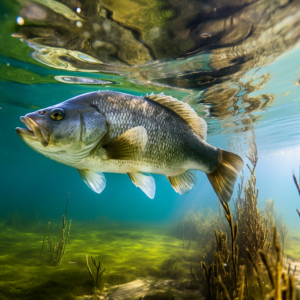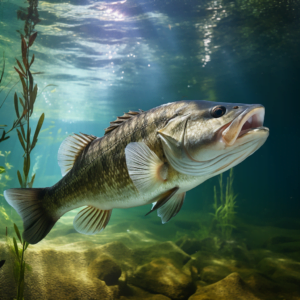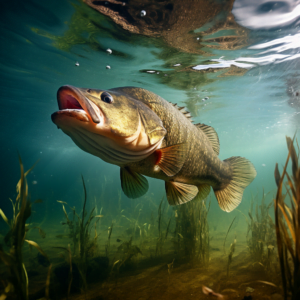Have you ever wondered if black sea bass is considered white meat? It’s a common question that many people have when it comes to this particular type of fish. In order to fully understand the truth behind this, it’s important to delve into the characteristics and composition of black sea bass flesh. Throughout this article, we will explore the topic in detail and provide you with all the information you need to know about whether black sea bass can be classified as white meat.
Black sea bass is a highly sought-after fish due to its delicate texture and mild flavor. However, its flesh is not necessarily classified as white meat. While the fillets of black sea bass may appear light in color, they actually fall into the category of lean fish, which is classified as either white or light pink. The color of the flesh is influenced by several factors, such as the diet of the fish and the habitat in which it lives. So, even though black sea bass is not technically considered white meat, it still shares many similarities with other white fish.
In terms of composition, black sea bass has a relatively low amount of fat compared to other fish, making it a healthier choice for those watching their calorie intake. It is also a good source of protein, vitamins, and minerals, such as vitamin B12 and selenium. The mild flavor and delicate texture of black sea bass make it versatile and easy to cook with. Whether it’s grilled, baked, or pan-seared, black sea bass can be enjoyed in a variety of dishes, from elegant seafood entrees to simple fish tacos.
In conclusion, while black sea bass is not considered white meat, its flesh is still light in color and offers a delicate texture and mild flavor. So if you’re looking for a lean and flavorful fish option, black sea bass is definitely worth considering. In the upcoming sections of this article, we will delve further into the characteristics and culinary uses of black sea bass, so stay tuned to learn more about this fascinating fish.
The Basics of Black Sea Bass
Appearance and Habitat
Black sea bass (Centropristis striata) is a popular species of fish found along the East Coast of the United States, from Maine to Florida. These fish have a distinctive appearance, with a sleek body and a mottled gray or black color. They have a large mouth with sharp teeth and their dorsal fin is long and continuous. On average, black sea bass can grow up to 24 inches in length and weigh around 7 pounds.
In terms of habitat, black sea bass are typically found in wrecks, reefs, and rocky areas. They prefer waters with structures where they can hide and seek shelter. These fish are known to be bottom-dwellers, meaning they spend most of their time near the ocean floor. Black sea bass are often found in depths ranging from 20 to 100 feet, although they have been known to venture into deeper waters during certain times of the year.
Diet and Feeding Habits
When it comes to their diet, black sea bass are opportunistic predators. They have a varied diet that includes small fish, crustaceans, mollusks, and other marine invertebrates. These fish are known to be ambush predators, meaning they lie in wait and then quickly strike at their prey. Black sea bass have sharp teeth that allow them to catch and consume their food efficiently.
Life Cycle and Reproduction
Black sea bass have a unique reproductive process. They are protogynous hermaphrodites, which means they start their lives as females and can later transition into males. As they mature, some female black sea bass undergo a sex change and become males. This can occur when there is a shortage of males in a particular area. The transition typically happens when the fish is around 2 to 5 years old.
During the breeding season, which usually occurs from late spring to early summer, male black sea bass attract females by producing a “thumping” sound using their swim bladder. Once the eggs are fertilized, the female releases them into the water, where they hatch into larvae after a few days. These larvae then grow and develop, eventually settling on the ocean floor as juveniles.
Color Controversy: Is Black Sea Bass White Meat?
Definitions and Distinctions
The color controversy surrounding black sea bass lies in whether its meat is considered white or not. In culinary terms, white meat commonly refers to the flesh of fish that is light in color, such as cod, haddock, and flounder. On the other hand, dark meat generally refers to fish with a stronger flavor and a darker color, such as salmon or tuna.
Understanding the Color Change
Black sea bass, despite its name, actually has white flesh. However, depending on how it is cooked, the color of the meat can vary. When raw, the flesh of black sea bass is translucent and typically appears white or pale pink. However, when cooked, the flesh turns white. This change in color occurs due to the denaturation of proteins in the fish’s muscle fibers during the cooking process.
Factors Influencing the Color
Several factors can influence the color of black sea bass meat after cooking. The cooking method, temperature, and duration can all affect the final color. Grilling, baking, or pan-searing the fish at high temperatures for short periods of time can result in a whiter meat color. Conversely, slow cooking methods, such as poaching or steaming, may yield a slightly pinkish hue.
Additionally, the diet of black sea bass can also impact the color of its meat. These fish primarily feed on small crustaceans and mollusks, which contain pigments known as carotenoids. Carotenoids are responsible for the vibrant colors seen in many marine organisms. While black sea bass do not contain high levels of carotenoids, the presence of these pigments in their diet can contribute to a slightly yellowish tint in the cooked meat.
Nutritional Aspects of Black Sea Bass
Protein Content
Black sea bass is a fantastic source of high-quality protein. It contains all the essential amino acids needed for optimal health, making it an ideal choice for individuals following a balanced diet. A 3-ounce serving of black sea bass provides approximately 20 grams of protein, making it a nutritious option for meeting daily protein requirements.
Vitamins and Minerals
In addition to protein, black sea bass also contains various vitamins and minerals essential for overall well-being. It is rich in vitamins B12 and B6, which play crucial roles in neurological function and red blood cell production. The fish is also a good source of minerals such as selenium, phosphorus, and potassium, which are important for maintaining healthy bones, muscles, and organ function.
Fatty Acid Profile
Black sea bass is known for its beneficial fatty acid profile, particularly its omega-3 fatty acids. Omega-3 fatty acids have been shown to have numerous health benefits, including reducing inflammation, improving heart health, and enhancing brain function. Consuming black sea bass can contribute to meeting the recommended daily intake of omega-3 fatty acids.
Preparing and Cooking Black Sea Bass
Cleaning and Filleting
When preparing black sea bass for cooking, it is essential to start by cleaning and filleting the fish properly. Begin by scaling the fish, removing any scales on the skin. Next, gut the fish by carefully cutting along its belly and removing the internal organs. Rinse the fish under cold water to remove any remaining debris. To fillet the fish, use a sharp knife to make an incision behind the gills and then slide the blade along the backbone until the fillet is separated.
Popular Cooking Techniques
Black sea bass can be cooked using various techniques, depending on personal preference and desired flavors. Grilling is a popular method that enhances the natural smoky flavors of the fish. Baking is also a common option since it allows for easy seasoning and the development of a crispy outer layer. Pan-searing and broiling are quick cooking methods that can result in a deliciously caramelized exterior. Experimenting with different cooking techniques can help discover the best way to enjoy black sea bass.
Flavor Pairings
The mild and delicate flavor of black sea bass pairs well with a variety of ingredients. Lemon, garlic, and herbs such as thyme or parsley complement the natural taste of the fish. Additionally, black sea bass can be enhanced with tangy sauces like citrus beurre blanc or fresh tomato salsa. Combining black sea bass with other seafood, such as shrimp or scallops, can create a flavorful seafood medley. The versatility of black sea bass allows for endless flavor possibilities.
Black Sea Bass in Culinary Traditions
Cultural Significance
Black sea bass holds cultural significance in various culinary traditions along the East Coast of the United States. It is a sought-after fish for both recreational and commercial purposes. In states like Massachusetts and Rhode Island, black sea bass is a staple seafood item, often featured on menus in local seafood restaurants. Its popularity stems from its abundance, delicious flavor, and versatile cooking options.
Traditional Recipes and Preparations
In New England, black sea bass is often prepared using traditional methods such as pan-frying or baking with a simple lemon and herb seasoning. The fish is prized for its firm yet flaky texture, which holds up well in various cooking techniques. It is also commonly used in fish chowders or stews, adding depth and richness to the dish.
Regional Variations
Along the coast of the Carolinas, black sea bass is frequently used in Southern cuisine. It is often fried and served with hush puppies, coleslaw, and tartar sauce, creating a classic Southern-style seafood platter. In Florida, black sea bass is commonly incorporated into Caribbean-inspired dishes, such as blackened fish tacos or jerk-seasoned fillets. The regional variations of black sea bass highlight the versatility of the fish in different culinary traditions.
Sustainable Fishing Practices
Conservation Efforts
Due to its popularity and demand, black sea bass has faced challenges in terms of sustainability. However, in recent years, conservation efforts have been implemented to ensure the long-term viability of this species. These efforts include catch limits, size restrictions, and seasonal closures to protect spawning populations. Additionally, ongoing research and monitoring help inform policymakers and fisheries managers about the health of black sea bass populations.
Fishing Regulations and Limits
To help maintain the black sea bass population, fishing regulations and limits have been put in place. These regulations focus on factors such as catch size, bag limits, and minimum sizes for harvested fish. It is crucial for anglers and commercial fishermen to adhere to these regulations to prevent overfishing and allow the fish population to replenish itself.
Sustainable Seafood Certifications
For consumers who want to ensure they are purchasing sustainably sourced black sea bass, looking for certifications such as the Marine Stewardship Council (MSC) or the Monterey Bay Aquarium’s Seafood Watch program can be beneficial. These certifications indicate that the fishery responsible for harvesting the black sea bass meets specific sustainability criteria and follows best fishing practices.
Black Sea Bass vs. Other Fish
Different Fish Species
When comparing black sea bass to other fish species, several factors come into play. In terms of appearance and taste, black sea bass is often likened to striped bass or grouper due to their similar texture and mild flavor. However, each fish has its own unique characteristics that set it apart.
Comparison of Nutritional Value
Black sea bass boasts a nutritional profile comparable to that of other commonly consumed fish species. It is lower in calories and fat compared to fatty fish like salmon, but it still provides valuable nutrients such as protein, vitamins, and minerals. Its omega-3 fatty acid content may be slightly lower than oily fish but is still beneficial for overall health.
Culinary Uses and Characteristics
In culinary terms, black sea bass can be a versatile choice due to its mild flavor and firm texture. It can be used interchangeably with other white-fleshed fish in many recipes. However, each fish species does have its unique taste, so experimenting and discovering personal preferences is encouraged.
Benefits of Including Black Sea Bass in Your Diet
Health Benefits
Including black sea bass in your diet can offer numerous health benefits. The fish is a good source of lean protein, which is important for muscle growth and repair. The omega-3 fatty acids found in black sea bass can help reduce inflammation and support heart health. Additionally, incorporating a variety of fish into your diet can contribute to a well-rounded nutrient intake.
Variety in Flavor and Texture
Black sea bass provides a welcome change in flavor and texture compared to other commonly consumed fish. Its mild taste and firm yet flaky texture make it a versatile option for various culinary preparations. Adding black sea bass to your diet can expand your palate and introduce new flavors to your meals.
Versatility in Cooking
Black sea bass lends itself well to a range of cooking techniques. Its firm flesh can withstand grilling, baking, frying, or pan-searing, allowing for diverse culinary creations. Whether you prefer a simple lemon and herb seasoning or a more complex flavor profile, black sea bass can easily adapt to your cooking preferences.
Misconceptions and Myths About Black Sea Bass
Mislabeling and Substitution
One common misconception surrounding black sea bass is the issue of mislabeling. Due to its popularity and similarity in appearance to other fish, it is not uncommon for restaurants and markets to mislabel or substitute other fish species as black sea bass. This can lead to confusion and inaccurate representation of the fish. It is important to verify that the fish being purchased or served is indeed black sea bass.
Health Concerns
Another myth surrounding black sea bass is the concern of mercury contamination. Like most fish, black sea bass does contain trace amounts of mercury. However, the level of mercury in black sea bass is considered low and poses minimal risk to most individuals. As with any seafood, it is recommended to consume black sea bass in moderation and follow guidelines for fish consumption, especially for pregnant women or those with specific health conditions.
Environmental Impact
There is a misconception that consuming black sea bass contributes to overfishing and negatively impacts the environment. However, sustainable fishing practices and strict regulations have been put in place to minimize the environmental impact of black sea bass fishing. By supporting sustainably sourced black sea bass and choosing fish with certifications, consumers can actively contribute to conserving the species and protecting the marine ecosystem.
Conclusion
In conclusion, black sea bass is a versatile and nutritious fish that offers both culinary enjoyment and health benefits. Despite its misleading name, black sea bass has white flesh that turns white when cooked. Its appearance and taste make it a favorite among seafood enthusiasts along the East Coast of the United States. By understanding the color change, nutritional aspects, and sustainable fishing practices associated with black sea bass, individuals can make informed choices when it comes to including this delicious fish in their diet.




